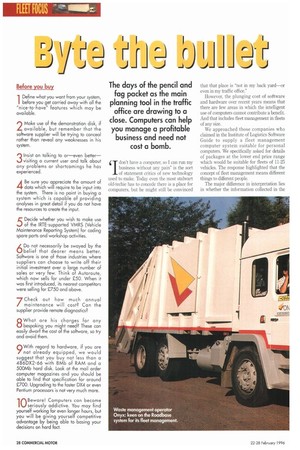I I
Page 30

Page 31

If you've noticed an error in this article please click here to report it so we can fix it.
yJ !ELI
The days of the pencil and fag packet as the main planning tool in the traffic office are drawing to a close. Computers can help you manage a profitable business and need not cost a bomb.
4 / don't have a computer, so I can run my business without any pain" is the sort
of statement critics of new technology used to make. Today even the most stalwart old-techie has to concede there is a place for computers, but he might still be convinced that that place is "not in my back yard—or even in my traffic office."
However, the plunging cost of software and hardware over recent years means that there are few areas in which the intelligent use of computers cannot contribute a benefit. And that includes fleet management in fleets of any size.
We approached those companies who claimed in the Institute of Logistics Software Guide to supply a fleet management computer system suitable for personal computers. We specifically asked for details of packages at the lower end price range which would be suitable for fleets of 11-25 vehicles. The response highlighted that the concept of fleet management means different things to different people.
The major difference in interpretation lies in whether the information collected in the system are historical facts or relate to future transactions. We concentrate on the former, principally because the systems involved with transactions tend to become rather open-ended and involved with accountancy functions. We also concentrate on management information based on operating experience which highlights areas of attention to eliminate waste and improve performance.
Such vehicle-based systems include information on standing costs which are vehicle excise duty, depreciation/leasing charges, licences, management and overheads; running costs which include fuel, oil, tyres, repairs and maintenance if done externally; driver costs; workshop costs which include spares, stocks, fitters, overheads/equipment/management and consumables; operations which include mileage, loads, drops and tachograph information.
Transaction-based systems include information on quotations, bookings, collections, scheduling, load manifests, trunking, delivery, invoicing and accountancy routines.
It is clear that the historical cost database will provide information which allows you to make quotations which will make a profit. Whether or not you actually do that will depend on a number of factors. For example, you might decide for commercial reasons to take on business at a rate which covers variable costs, but only makes a partial contribution to standing costs. The point is that you have the knowledge to know what you are doing rather than quoting on the basis of a rule of thumb or seat of the pants as previously may have been the case.
El by John Kelly




































































































